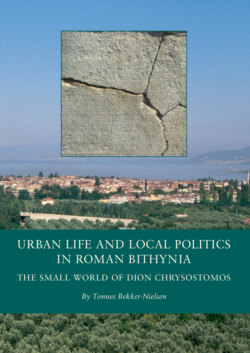Читать книгу Urban Life and Local Politics in Roman Bithynia - Tonnes Bekker-Nielsen - Страница 13
На сайте Литреса книга снята с продажи.
Townscapes and landscapes
ОглавлениеThere are not many monumental remains to inform us about the topography and appearance of ancient Prusa or Nikomedia. Both are now large cities, their ancient cores overlaid by modern construction and roads. In addition, Nikomedia is plagued by frequent earthquakes – by the late fourth century most of the Hellenistic and early Roman city had been destroyed beyond recognition. Fortunately, neither seismic activity nor modern construction could obliterate the characteristic hillside topography of Nikomedia and Prusa, giving the modern observer some “feel” of the relation of the city to its environment and useful pointers for interpreting the written evidence. The Acropolis that formed the centre of ancient Prusa remains an oasis of quiet at the epicentre of Bursa’s bustling traffic and the Acropolis on the crest above modern Nikomedia still dominates the city. Little is left above foundation level, however; for an impression of the splendours of the imperial residence, one must go to the western imperial capital at Trier or to Diokletian’s retirement palace in Split on the Adriatic.
On the face of it, it seems much easier to visualize the ancient appearance of Nikaia. The course of the main streets, the theatre and numerous minor monuments all help the modern visitor create a mental image of the ancient city; but she needs to remember that much of what is visible today is not the Nikaia of Pliny or Dion, but later – even the church where the Nicene council was held in AD 325 has been replaced by a later structure, today’s Aya Sofya Camii.
Outside the city gates, archaeological evidence is even scarcer, but again it is Nikaia that offers the most complete picture. A visitor approaching Nikaia from the east, cresting the hill and seeing the city spread out on the lakeshore, then following the road that runs parallel to the aqueduct and skirts the modern cemetery, finally entering the city through the east gate of the Roman walls, will have a fairly good impression of what it was like to approach Nikaia from the same direction some 1,700 years ago (fig. 5). Further afield, few ancient farmsteads or villas have been located, but inscriptions found within the city’s territory and naming farm stewards testify to their existence. Even without the bronze sculpture that once adorned it, the extravagant, obelisk-like funeral monument of C. Cassius Philiskos to the north-west (figs. 22-24) is striking evidence of the wealth enjoyed by some Nikaian landowners.
Fig. 5. Nikaia seen from the east (author’s photo).
Within the territory of Nikomedia and Prusa, evidence for rural settlement is much sparser. From other parts of the empire, we have evidence for a fairly close-meshed pattern of agricultural exploitation close to the cities; that it has not been recorded in Bithynia so far is perhaps mainly due to the absence of systematic investigation. In the hinterland of Sinope on the coast of Pontos, recent archaeological survey1 has revealed a pattern of intensive Roman settlement, and a similar research effort might yield comparable results in Bithynia. But time is running out, and in the ever-expanding suburbs of Bursa and Izmit, housing estates and industrial plants are obliterating all surface traces of ancient habitation and rendering systematic archaeological survey impossible. For the time being, perhaps for all time, we must rely on the example of Nikaia and the literary sources for an impression of the cultural landscape of rural Bithynia.
The road network of Roman Bithynia is not well preserved. Although its main outlines are known and key points (city gates, bridges, mountain passes, fords etc.) can be securely located, the roads themselves are rarely preserved in their original state, more often ploughed over or overlaid by modern highways. The third-century Itinerarium Antonini lists only one route through our region, Chalkedon-Nikomedia-Nikaia-Ankyra; the same route is decribed in more detail in the Bordeaux Itinerary of the following century.2 The Tabula Peutingeriana, a medieval copy of a late Roman itinerary in map form (fig. 6) shows several routes through Bithynia. One, coming from Hadrianoutherai, passes through Prusa, Prusias ad Mare/Kios (which the cartographer has rendered as two distinct places) and along the southern shore of lake Askanios to the port of Kyzikos (which appears as an inland city on the Tabula). A second route from Anatolia passes through Nikaia and continues eastward along the northern shore of the lake, with a branch road leading north-westwards to the Gulf of Izmit. A third route, coming from Amaseia and Pompeiopolis, leads through Nikomedia to Chalkedon. Some routes can also be identified from remains of late Roman bridges (e.g., fig. 35) and finds of Roman milestones.3
Fig. 6. Detail of the Tabula Peutingeriana (Staatsbibliothek, Vienna)
